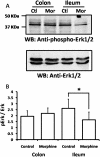The role of β-arrestin2 in the mechanism of morphine tolerance in the mouse and guinea pig gastrointestinal tract
- PMID: 22129596
- PMCID: PMC3286318
- DOI: 10.1124/jpet.111.186320
The role of β-arrestin2 in the mechanism of morphine tolerance in the mouse and guinea pig gastrointestinal tract
Abstract
β-Arrestin2 has been reported to play an essential role in analgesic tolerance. Analgesic tolerance without concomitant tolerance to constipation is a limiting side effect of chronic morphine treatment. Because tolerance to morphine develops in the mouse ileum but not the colon, we therefore examined whether the role of β-arrestin2 in the mechanism of morphine tolerance differs in the ileum and colon. In both guinea pig and mouse, chronic in vitro exposure (2 h, 10 μM) to morphine resulted in tolerance development in the isolated ileum but not the colon. The IC(50) values for morphine-induced inhibition of electrical field stimulation contraction of guinea pig longitudinal muscle myenteric plexus shifted rightward in the ileum from 5.7 ± 0.08 (n = 9) to 5.45 ± 0.09 (n = 6) (p < 0.001) after morphine exposure. A significant shift was not observed in the colon. Similar differential tolerance was seen between the mouse ileum and the colon. However, tolerance developed in the colon from β-arrestin2 knockout mice. β-Arrestin2 and extracellular signal-regulated kinase 1/2 expression levels were determined further by Western blot analyses in guinea pig longitudinal muscle myenteric plexus. A time-dependent decrease in the expression of β-arrestin2 and extracellular signal-regulated kinase 1/2 occurred in the ileum but not the colon after 2 h of morphine (10 μM) exposure. Naloxone prevented the decrease in β-arrestin2. In the isolated ileum from guinea pigs chronically treated in vivo with morphine for 7 days, neither additional tolerance to in vitro exposure of morphine nor a decrease in β-arrestin2 occurred. We conclude that a decrease in β-arrestin2 is associated with tolerance development to morphine in the gastrointestinal tract.
Figures








Similar articles
-
Site and mechanism of morphine tolerance in the gastrointestinal tract.Neurogastroenterol Motil. 2014 Oct;26(10):1361-7. doi: 10.1111/nmo.12443. Neurogastroenterol Motil. 2014. PMID: 25257923 Free PMC article. Review.
-
Differences in the characteristics of tolerance to μ-opioid receptor agonists in the colon from wild type and β-arrestin2 knockout mice.Eur J Pharmacol. 2012 Jun 15;685(1-3):133-40. doi: 10.1016/j.ejphar.2012.04.001. Epub 2012 Apr 11. Eur J Pharmacol. 2012. PMID: 22521552 Free PMC article.
-
Cross-tolerance and convergent dependence between morphine and cannabimimetic agent WIN 55,212-2 in the guinea-pig ileum myenteric plexus.Eur J Pharmacol. 1999 Jul 9;376(3):265-71. doi: 10.1016/s0014-2999(99)00389-1. Eur J Pharmacol. 1999. PMID: 10448886
-
Specific localization of β-Arrestin2 in myenteric plexus of mouse gastrointestinal tract.PLoS One. 2014 Aug 1;9(8):e103894. doi: 10.1371/journal.pone.0103894. eCollection 2014. PLoS One. 2014. PMID: 25083714 Free PMC article.
-
Correlation between acetylcholine release and neuronal activity in the guinea-pig ileum myenteric plexus; effect of morphine.Neuroscience. 1982 Feb;7(2):327-40. doi: 10.1016/0306-4522(82)90270-6. Neuroscience. 1982. PMID: 6281683 Review. No abstract available.
Cited by
-
Effects of methylnaltrexone on guinea pig gastrointestinal motility.Naunyn Schmiedebergs Arch Pharmacol. 2013 Apr;386(4):279-86. doi: 10.1007/s00210-013-0833-8. Epub 2013 Jan 30. Naunyn Schmiedebergs Arch Pharmacol. 2013. PMID: 23361094 Free PMC article.
-
β-arrestins: regulatory role and therapeutic potential in opioid and cannabinoid receptor-mediated analgesia.Handb Exp Pharmacol. 2014;219:427-43. doi: 10.1007/978-3-642-41199-1_22. Handb Exp Pharmacol. 2014. PMID: 24292843 Free PMC article. Review.
-
Site and mechanism of morphine tolerance in the gastrointestinal tract.Neurogastroenterol Motil. 2014 Oct;26(10):1361-7. doi: 10.1111/nmo.12443. Neurogastroenterol Motil. 2014. PMID: 25257923 Free PMC article. Review.
-
cPKCγ membrane translocation is involved in herkinorin‑induced neuroprotection against cerebral ischemia/reperfusion injury in mice.Mol Med Rep. 2017 Jan;15(1):221-227. doi: 10.3892/mmr.2016.5995. Epub 2016 Dec 6. Mol Med Rep. 2017. PMID: 27922694 Free PMC article.
-
Efficacy and ligand bias at the μ-opioid receptor.Br J Pharmacol. 2013 Aug;169(7):1430-46. doi: 10.1111/bph.12222. Br J Pharmacol. 2013. PMID: 23646826 Free PMC article. Review.
References
-
- Bailey CP, Smith FL, Kelly E, Dewey WL, Henderson G. (2006) How important is protein kinase C in mu-opioid receptor desensitization and morphine tolerance? Trends Pharmacol Sci 27:558–565 - PubMed
-
- Bohn LM, Gainetdinov RR, Lin FT, Lefkowitz RJ, Caron MG. (2000) Mu-opioid receptor desensitization by beta-arrestin-2 determines morphine tolerance but not dependence. Nature 408:720–723 - PubMed
-
- Bohn LM, Lefkowitz RJ, Gainetdinov RR, Peppel K, Caron MG, Lin FT. (1999) Enhanced morphine analgesia in mice lacking beta-arrestin 2. Science 286:2495–2498 - PubMed
Publication types
MeSH terms
Substances
Grants and funding
LinkOut - more resources
Full Text Sources

